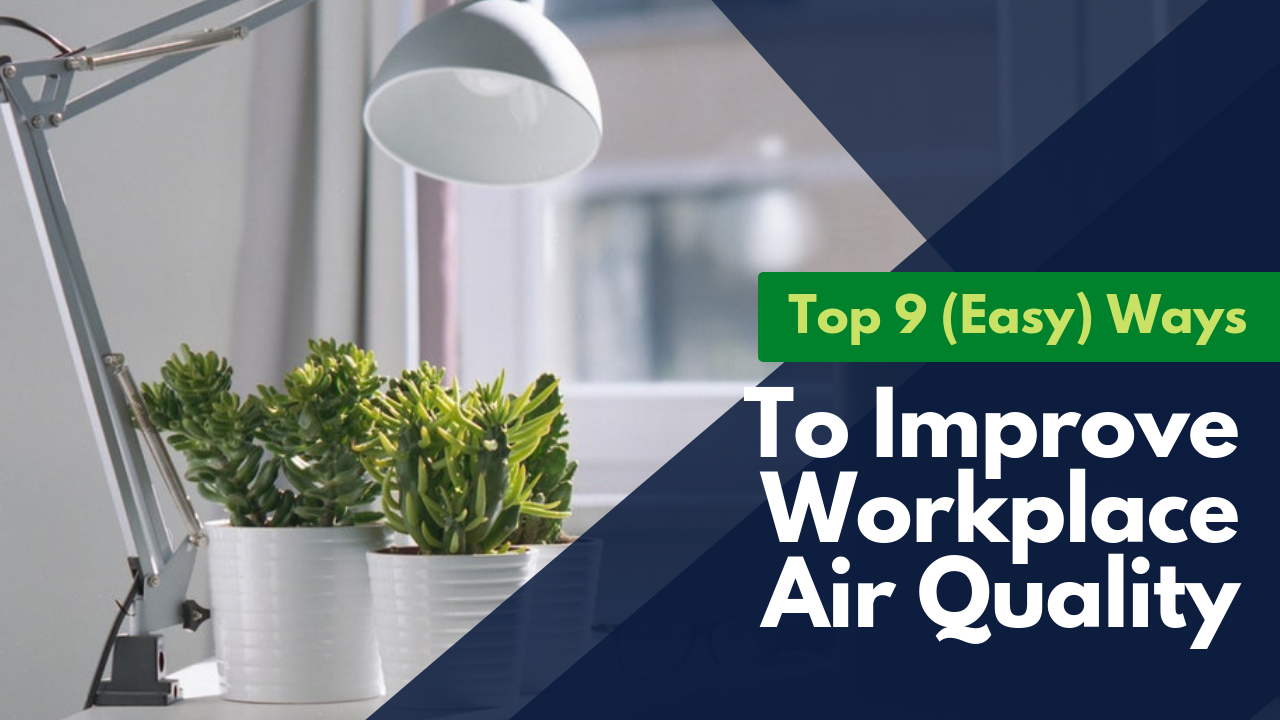- How clean is the air that you, and your workspace members, breathe?
- Quality, fresh and clean air is vital to good health, while air that contains pollutants can lead to nausea, headaches, asthma, respiratory irritation, and allergies.
- Improve your workspace air quality by maintaining vents and filters, cleaning up after spills, and installing potted plants.
Though much of the talk around pollutants centers around the outside, human beings spend most of their time indoors at home or in the workplace, making it important for individuals to understand how indoor air quality affects their day to day lives and health.
Breathing quality, fresh, and clean air indoors is vital to good health. According to the International WELL Building Institute, “pollutants generated indoors can lead to a variety of symptoms and health conditions.” These pollutants include volatile organic compounds (VOCs), combustion byproducts, and airborne particulate matter, and they can lead to nausea, headaches, asthma, respiratory irritation, and allergies.
The damage goes beyond an individual’s physical health. Studies have found that poor air quality can be highly detrimental to the mind, including negatively impacting a person’s productivity and cognitive performance.
Suggested Reading: “3 Invisible Elements that Greatly Impact Workplace Productivity”
One study found that for seven of nine scales of decision-making performance (basic activity, applied activity, task orientation, initiative, information usage, breadth of approach, and basic strategy), the more CO2 concentration in the air, the worse people performed in these activities.
Good indoor air quality in the workplace, therefore, can improve individual health and business economic performance. According to the United States Environmental Protection Agency (EPA):
“Controlling indoor air quality involves integrating three main strategies. First, manage the sources of pollutants either by removing them from the building or isolating them from people through physical barriers, air pressure relationships, or by controlling the timing of their use. Second, dilute pollutants and remove them from the building through ventilation. Third, use filtration to clean the air of pollutants.”
9 Easy Ways to Improve Air Quality in the Workplace
1. Keep the workplace clean
A clean indoor environment reduces dust and mold levels. You should vacuum carpets, rugs, and upholstery with a HEPA filter; you also need to clean curtains, windows, drapes, and clear any desk clutter (like stacks of paper, stacks of books, cables, etc.).
2. Change and give maintenance to your air filters
HVAC air filters need to be taken care of properly. This requires regular maintenance to keep filters clean and changing them every six to twelve months. Clogged and dusty filters reduce airflow and increase the amount of pollutants and allergens in a closed environment.
3. Keep air vents unblocked
If furniture, boxes, storage units, chairs, or anything else is blocking the path of air vents, then the air won’t circulate properly. This can lead to workplaces that feel stuffy, which can result in a myriad of health problems.
4. Open your windows
Use as much fresh air as possible. If your workplace has windows, make sure you crack them open (weather permitting) to make it easier for air to circulate around your workplace. Open windows also help flush out stale air.
5. Clean up immediately after spills
Did someone drop a glass of water or a cup of coffee or tea? Make sure it’s cleaned up ASAP. The same goes for leaks, as damp areas and excess moisture support the growth of mold and mildew, which significantly affect air quality.
6. Dispose of garbage promptly and store food properly
Food attracts pests and they can also generate unpleasant odors. Make sure you’re disposing of kitchen garbage regularly and promptly and that all workspace users are storing their food properly. This also requires that you do regular refrigerator and kitchen cleanups (throwing away food that’s gone bad, disinfecting dining areas, etc.).
7. Embrace plants (but take proper care of them)
Plants in the workplace offer various health benefits. They also make a workplace more beautiful and they can even help reduce noise levels. However, if you’re going to have plants in the office, you need to take proper care of them (watering them and cleaning the dust from their leaves).
8. Invest in the right products
According to the EPA, “many common products used in offices, like solvents, adhesives, cleaners, and pesticides can give off pollutants and odors, as can office equipment such as copiers, printers, and fax machines.” These types of products should be placed separately and provided with separate ventilation systems. It’s also important that you carefully select cleaning products and paint; you’ll want to pick products that don’t have any harsh smells and that are environmentally friendly.
9. Conduct regular air quality tests
Testing your workplace’s air quality will provide you with the right information and insights to make sure your efforts are well-directed and efficient. These tests measure air flow, humidity levels, ventilation, odors, leaks, water damage, mold growth, and more. If you notice more people are suffering from allergies or getting sick than usual, you might want to schedule a test.


 Dr. Gleb Tsipursky – The Office Whisperer
Dr. Gleb Tsipursky – The Office Whisperer Nirit Cohen – WorkFutures
Nirit Cohen – WorkFutures Angela Howard – Culture Expert
Angela Howard – Culture Expert Drew Jones – Design & Innovation
Drew Jones – Design & Innovation Jonathan Price – CRE & Flex Expert
Jonathan Price – CRE & Flex Expert













